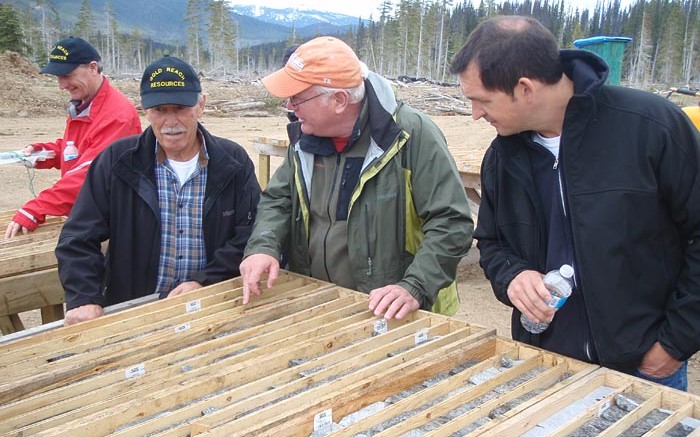VANCOUVER — With 53 drill holes completed in 2013, Gold Reach Resources (TSXV: GRV; US-OTC: GRJVF) is showing that the hills around Houston reliably host copper, gold, silver and molybdenum.
Houston is a town in northwest B.C. The Ootsa property is nearby, as is the operating Huckleberry mine owned by Imperial Metals (TSX: III; US-OTC: IPMLF) and a consortium of Japanese partners. In fact, Ootsa and Huckleberry are neighbours, with Ootsa east across the Morice River from the grounds of the operating mine.
Ootsa is home to two defined copper–gold–silver–moly deposits — Seel and Ox — plus the Damascus historic silver resource. Ox and Seel are both near-surface porphyry deposits.
The Seel deposit has two lobes, West and East. The goal at Seel in 2013 was to probe the West Seel zone for its potential to expand north and test East Seel’s eastward expansion potential, while infill drilling both zones to improve resource confidence.
The efforts have been returning good results. At West Seel, Gold Reach’s drills have defined high-grade mineralization that starts just a few metres below surface. So far drills have tracked the zone along 125 metres strike, 150 metres width and 40 metres of thickness.
The latest intercept from the higher-grade zone came from hole 171, which cut 14 metres grading 0.25% copper and 0.76 gram gold per tonne, 8.06 grams silver per tonne and 0.018% moly. Earlier, hole 169 cut 26 metres of 0.92% copper, 0.42 gram gold, 28.19 grams silver and 0.009% moly. Gold Reach says that future drilling will better delineate the extent of this higher-grade zone, which sits above and within a larger mineralized body.
The larger body returns lower grades, but over longer lengths. For example, hole 176 cut 198 metres grading 0.21% copper, 0.12 gram gold, 4.96 grams silver and 0.013% moly starting 44 metres downhole, followed 25 metres later by 58 metres averaging 0.19% copper, 0.21 gram gold, 2.29 grams silver and 0.012% moly.
Drills testing East Seel have been encountering higher grades than the resource average, including the best hole drilled at East Seel to date. Hole 155 cut 238 metres grading 0.38% copper, 0.47 gram gold and 1.93 grams silver, starting 30 metres downhole and including 44 metres of 0.62% copper, 0.67 gram gold and 2.76 grams silver.
Other results are promising. Hole 172 returned 95.8 metres grading 0.3% copper, 0.35 gram gold and 1.07 grams silver from 39 metres depth; hole 174 cut 91.5 metres averaging 0.36% copper, 0.35 gram gold and 1.45 grams silver from 37 metres depth; and hole 177 intersected 186 metres carrying 0.39% copper, 0.53 gram gold and 1.86 grams silver, starting 27 metres downhole and including 46 metres of 0.68% copper, 1.05 grams gold and 2.73 grams silver.
At the start of 2013 Gold Reach updated the Seel resource estimate. Together, East and West Seel host 67.8 million indicated tonnes grading 0.21% copper, 0.17 gram gold, 2.02 grams silver and 0.018% moly, plus 410.9 million inferred tonnes averaging 0.16% copper, 0.11 gram gold, 1.95 grams silver and 0.018% moly.
The company plans to update the resource estimate with the drill data collected in 2013.
In 2013 Gold Reach completed two induced-polarization surveys at Ootsa: a widely spaced survey of the grounds next to Ox and Seel, and a detailed re-survey of the deposits outlining their chargeability and resistivity characteristics.
The first survey identified two large geophysical anomalies at Ootsa. One is east of the Ox deposit, and has been dubbed “East Ox.” The other is west of Ox and has been named “West Ox.” Gold Reach says both anomalies are similar to the anomaly associated with Ox in containing corresponding chargeability highs and resistivity lows. The two anomalies and the Ox deposit lie along trend from the Huckleberry mine to the west.
Gold Reach updated the Ox resource estimate a year ago, pegging the deposit at 52.7 million inferred tonnes grading 0.21% copper, 0.03 gram gold, 1.25 grams silver and 0.022% moly.
The Ox deposit sits 4 km north of Seel and is shaped like a “C.” Copper and moly grades are highest at the bottom of the C, which is where the zone remains open for expansion. Gold Reach did not drill at Ox last year, but plans to return in 2014.
Gold Reach’s share price lost 4¢ on news of the latest drill results to close at $1.16. The company’s share price has spent the last 52 weeks bouncing up and down, between a $1.65 high and a 75¢ low. Gold Reach has 35.5 million shares outstanding.


Be the first to comment on "Gold Reach keeps pulling mineralization out of Ootsa"